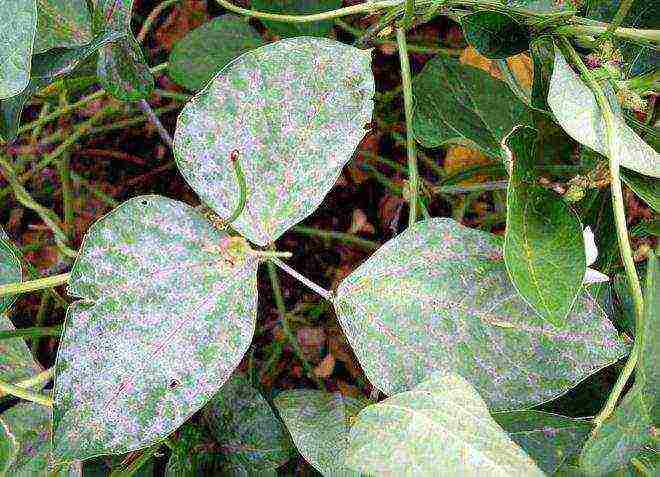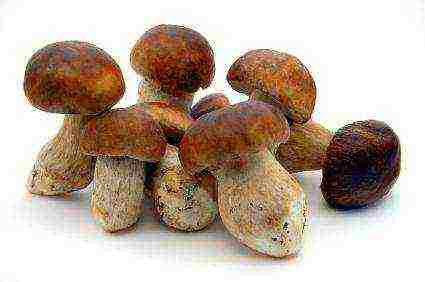Content [show]
The peanut, which is so loved by many, can be grown in the garden. Growing peanuts is not as difficult as it might seem. It is only necessary to select and sow an early-ripening variety, and also strictly follow all agrotechnical recommendations.
Peanut
Biological features
Despite the fact that peanuts are considered a nut, in reality they are a distant relative of beans. This is an annual legume crop with a height of about 0.5-0.6 m, having a taproot, which, in turn, deepens by 1.5 m.The diameter of the upper part of the rhizome can reach 1 m, which, in fact, explains the resistance of peanuts to droughts.
Peanuts on the field
The leaves are paired, have a dark green tint. Flowers are collected in inflorescences in the leaf axils and are orange or yellow. One flower develops in the inflorescence, due to which the flowering phase lasts from the last days of June until the onset of autumn cold weather. Flowers open at about 7 am and bloom until noon.
Peanut bush
Note! Each bush produces an average of 30-70 beans and about 2,000 flowers.
A few days after flowering, a young ovary begins to develop in the place of each flower, which is a kind of aerial "root", bending and heading towards the ground. In the language of science, these ovaries are called gynophores and are designed to protect offspring from drought and heat. The upper part of the gynophore, after penetrating into the ground, grows rapidly and forms a pod in the shape of a cocoon or cylinder (for this reason, soil looseness is so important when growing a crop). Each such bean produces 1 to 4 oval-shaped pink seeds.
Peanut fruit
Basic requirements for growing peanuts on the site
Consider what conditions should be provided for the normal development of culture.
- If peanuts are grown in large quantities in order to obtain oil, then it should be borne in mind that the color depends directly on the soil. The oil obtained from the beans planted in light soil will be light, and in the dark - accordingly, dark.
- Nuts form in the ground, so it must be loose. As for the specific type, black soil, neutral or sandy loam soil is most suitable for peanuts.
The soil must be loose
- The culture grows well in the beds where tomatoes, cucumbers, potatoes and cereals were previously grown.It is undesirable to plant peanuts after other legumes (peas, beans, etc.).
- The most suitable temperature for peanuts is considered to be 20-27 ° C. If this indicator falls below 15 ° C or exceeds 30 ° C, then the plants will simply stop growing.
- During the period of flowering and formation of underground beans, plants need constant moisture, but water stagnation should not be allowed. And around September, during the period of seed ripening, excess moisture can slow down this process.
Avoid stagnant water
- The beds where peanuts are planted should be ventilated.
- Finally, the bushes should be well lit. It is unacceptable to have plants near peanuts that can shade it.
Peanuts grow well in sunny places
If at least one of the above conditions is violated, then the culture will begin to hurt - spots form on its leaves, indicating the development of root rot.
Stage one. Preparing the site
Start preparing the beds in the fall. Dig the selected area to the depth of a bayonet shovel, then apply organic fertilizer - compost, humus or wood ash at the rate of 2-3 kg / m². In the spring, cultivate the site (to a depth of no more than 10 cm) and remove the weeds along with the roots. It is also advisable to add nitrophosphate (about 50 g / m²).
Cultivation
Stage two. Choosing and preparing planting material
To get the greatest yield, give preference to zoned varieties. Buy them from a reliable gardening store or alternatively from friends or neighbors. As seeds, not only beans (crushed / whole) can be used, but also husked seeds.
Planting material
The most common varieties of peanuts in temperate climates include the following:
- Stepnyak;
- Klinskaya;
- Krasnodarets 14;
- Valencia 433.
Note! When buying, be extremely careful so that you do not slip fried or otherwise processed grains. Otherwise, time and money will be wasted.
Preparation of planting material for peanuts
Groundnuts can be grown both by sowing in open soil and through seedlings. If you prefer the first option, then use only those seeds that were collected no more than 2 years ago (germination is lost over the years). Regardless of the chosen method, the grain must be germinated around the last days of April. To do this, follow the instructions below.
Step one. Take the seeds and immerse them in a weak solution of potassium permanganate for 15 minutes to disinfect.
Potassium permanganate solution
Step two. Rinse the seeds with running water and soak for germination. After 10 days, the first shoots are formed.
Soak
Step three... Temper the resulting sprouts. To do this, during the day, keep them in a room with a temperature of the order of 3 ° C for several days, but transfer them overnight to where the temperature is at room temperature.
Sprouts
Stage two. Landing
Further, the germinated seeds are sown in the soil or grown for seedlings. Let's get acquainted with the features of each of the methods.
Method one. Planting in open soil
When the temperature regime is at least 20 ° C (for the forest-steppe, this is usually mid-May), and the ground at a 10-centimeter depth warms up to at least 15 ° C, you can start sowing germinated seeds. If the temperature is lower, then the seeds will simply rot before they can sprout.
Prepare the planting site using one of two possible schemes:
- square-nested (0.7x0.7 m or 0.6x0.6 m), in which 5-6 grains must be placed in the hole;
- wide-row (the distance between the bushes is 15-20 cm, the row spacing is somewhere around 60 cm).
Groundnut peanuts: cultivation
In both the first and second methods, the sowing depth should be 6-8 cm. Take only large grains, since small or damaged seedlings may not give rise. After sowing, cover the holes with earth, compact slightly.It is worth noting that the shell of nuts contains many beneficial microorganisms, so many gardeners grind it and place it in the holes during planting.
Note! At first, protect the planting from birds (such as magpies, crows, etc.), because they can destroy not only young shoots, but also seed.
How to protect peanuts
To protect yourself from the bear, you can make one simple bait: collect the grain and cleanings, dig it all in on the garden bed, and then cover it with a piece of roofing material. Pour manure or plant debris on top. Make several of these lures and look at them from time to time, collecting a bear.
Growing peanuts in the field
Video - Planting peanuts
Method two. Growing seedlings
As noted earlier, peanuts can also be grown using seedlings. In this case, proceed according to the following algorithm.
Planting peanuts in a cup
Table. How to grow peanuts seedlings
Conditions for growing good seedlings of peanuts
Stage three. Further care
In May, the land is still sufficiently moistened with melt water, which means that it should be watered only after the mass emergence of shoots (twice a month, using only water heated in the sun). It is better to resort to drip irrigation or, alternatively, furrow irrigation. Young shoots will immediately give a yellow color.
An equally important condition for a good harvest is periodic hilling.
Hilling peanuts
Perform this procedure several times per season.
- Before flowering, spud the plants to a height of 0.5-0.7 m.
- For the second time, carry out hilling 10 days after the beginning of flowering.
- In the future, do this every 10 days, over time, reducing the distance between the gynophores that appeared during flowering and the soil. Make the final hilling in early August.
Using the technique for hilling
Video - Hilling peanuts
Finally, add min. fertilizers, namely 450 g of potassium (if we are talking about sandy loam soil), 500-600 g of phosphorus and 450-600 g of nitrogen for each hundred square meters of land.
Apply top dressing:
- during the formation of true leaves;
- while tying buds;
- during fruit setting.
Stage four. Harvesting the harvest
Peanut harvesting process
By mid-autumn, the fruits should ripen. Roughly in early October, when the weather is dry, dig out the bushes with a shovel. Lightly shake each bush off the ground, turn it over and place it on the ground with the root system upward so that the fruits dry out a little. Then move them indoors or under a shed to dry and keep them there for at least 4 days.
Snapshot of ripe peanuts
Once the stems have dried naturally, start to process the peanuts. Next, dry the fruits at room temperature and place them in cardboard boxes for storage (you can use small canvas bags instead of the latter). Store fruits in a dry and well-ventilated place.
Note! To speed up the drying process, you can use, for example, an oven, but the temperature in the appliance should not exceed 40 ° C.
About other ways to grow peanuts
There are other, less popular cultivation methods that, in fairness, should also be familiar (at least in general terms).
In warm beds
How to make warm beds
Warm beds
When choosing one method or another, you should pay attention to warm beds. Prepare the latter in autumn or early spring, following the instructions below.
Step one... Decide on a place and dig trenches of 15-20 cm. The recommended width of the beds is 1 m, as for the length, it can be any.
Step two... Place the top layer of soil on one side of the trench and the bottom layer on the other.
Step three... Cover the bottom with plant remains, sprinkle them with a small amount of soil. Sprinkle rotted compost on top.
Step four. Cover the beds with a top layer of earth.
After about 60 days, the beds will consist of warm, nutritious soil, which is ideal for growing crops.
Heating the beds with a cable
Houses
After growing the seedlings, you can leave yourself 2-3 sprouts to grow on the windowsill.
Step one. Take a wide container and fill it with earth mixed with sand / humus.
Step two. Plant the plants in the soil, place the container on the lightest windowsill (there should be no drafts in the room).
Peanut sprouts
Step three. Expect a flower to emerge and a pod to form. Make sure that the shoots do not go beyond the container, otherwise the set fruit will not develop.
Step four. Loosen and water the soil periodically.
Step five... When the plant stops growing and the leaves turn yellow, you can harvest the fruit.
Peanuts on the windowsill
In the greenhouse
In greenhouse conditions, the culture feels quite comfortable, especially next to tomatoes (the latter should not be located too densely so as not to shade the peanuts). In this case, the peanuts will share nitrogen with the tomatoes, and you only need to huddle the bushes twice (in June).
In general, planting and care is not much different from what needs to be done when growing in open soil, except that the vents and ends of the greenhouse need to be periodically opened for ventilation. Harvesting can start as early as September.
Video - Features of growing peanuts
Many summer residents love to experiment with growing new crops. It's nice to surprise the guests by putting something so unusual on the table, proudly declaring: "I grew it myself in the garden." If you are one of these passionate people, try growing peanuts. By the way, this task is not so difficult, and in our article we will acquaint you in detail with this culture and cultivation techniques.
It turns out that this is not a nut at all.
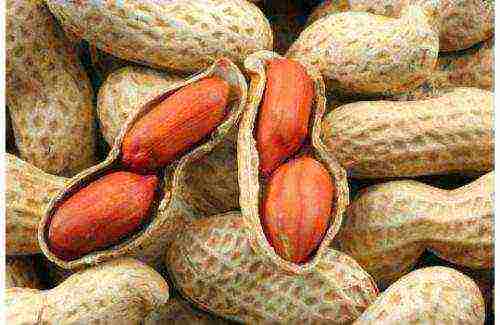
Although peanuts are called walnuts, they are actually a relative of common beans because they are belongs to the same family - legumes. This plant looks like this:
- The bush has a height of 0.5-0.6 m.
- The stem is branched.
- Leaves are paired, dark green.
- Flowers are yellow, small, sometimes their number reaches 2 hundred. The lower ones gradually sink to the ground, penetrate into it and there they turn into a bean, which is called a nut. In each shell, from 1 to 4 seeds of light pink color are formed. 30-70 nuts are collected from one bush.
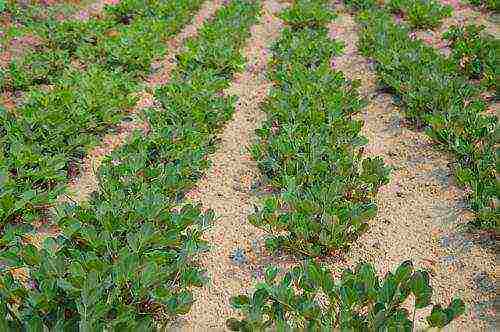
About the benefits of peanuts
Of course, peanuts are delicious, especially toasted, but these are not all of its advantages, because it contains what the body needs so much:
- carbohydrates;
- proteins;
- fats;
- linolenic acid, vitamins B, E, if the beans are processed into oil.
And they also make peanut butter from these delicious nuts, which in its energy value is the same as meat, but healthier due to the content of folic acid in it.
Growing peanuts
To grow this plant of the legume family in our temperate climate, you should buy seeds of the following varieties:
- Krasnodarets 13;
- Krasnodarets 14;
- Steplyak;
- Valencia 433;
- Klinskaya.
Be carefull: Make sure that you are not sold processed or roasted beans, otherwise you will waste money, time, and you will not wait for seedlings.
To grow peanuts at home, you need to know what it takes to grow.
Conditions for plant development
- Since nuts can develop exclusively in the ground, a good harvest is possible only in loose chernozem, sandy loam or neutral soil. The presence of magnesium and potassium, as well as humus in large quantities, is required. Hilling bushes up to 3 times per season, we will increase the amount of ovary.
- Since peanuts are native to South America, where they grow like a perennial, the second condition for their successful development is temperature. The optimal one is 20-27 degrees C, and as soon as it rises above +30 or drops below +15, the bushes stop growing.
- The third prerequisite for successful cultivation is good illumination.The presence of nearby plants shading this culture is unacceptable.
- It is important that the bed on which this legume is planted is well ventilated.
- When peanuts are in bloom and pods are formed underground, they require constant moisture, not stagnant water. In September, when the seeds are ripe, excess moisture can slow this process down.
- The plant develops well in the beds, where cabbage, cucumbers, potatoes, tomatoes, cereals were grown before it, but in no case beans, peas, i.e. its relatives are legumes. But after peanuts, any crops feel good in the garden.
- If you are going to grow it in large quantities and get oil from it, then know that the color of peanuts depends on the soil. Beans grown in light soil will make the oil lighter and darker soil.
Important: If the conditions necessary for the growth and development of peanuts are violated, the plant begins to ache - spots appear on the leaves, which indicates the presence of root rot.
How to grow peanuts: ways
Groundnuts are grown through seedlings and by sowing in open ground. Grains harvested no more than 2 - 3 years ago should be taken as planting material. then they lose their germination. In any case, the seeds should be germinated first. This is done at the end of April:
- We lower the seeds in a weak solution of potassium permanganate for disinfection.
- Rinse and soak for germination. In 10 days sprouts will appear.
- We harden the germinated seeds, keeping them indoors for 2-3 days at a temperature of about +3 degrees during the daytime, and at night we transfer them to a place where the temperature is room temperature.
Seedlings are grown from sprouted seeds or sown on a garden bed. First, let's look at how to grow peanuts with seedlings. So:
- we fill the cups with light soil in early April;
- we bury the seeds in the ground by 3 centimeters;
- we place the cups on a sunny windowsill;
- water in moderation;
- in the meantime, we prepare the garden bed - we dig it up and remove the weeds;
- We plant the plants at the beginning of June with an interval of 15 - 20 cm from each other and 0.6 - 0.7 m row from the row.

If you decide to plant the peanuts immediately in the ground, then as soon as a constant air temperature of at least 20 degrees C is established, and the ground at a depth of 10 cm warms up to 15 degrees C, we proceed to sowing the germinated seeds. The planting pattern is identical to that used for planting seedlings, and the depth is 60 - 80 mm. Sprouted seeds are planted in the ground not only in order to see the harvest faster, but also in order to protect them from damage by the bear.
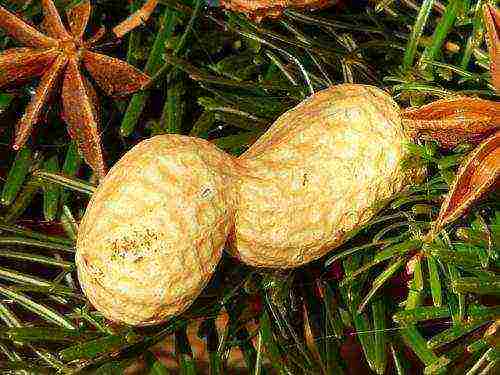
Good to know: on the shell, in which the nuts are located, many useful microscopic fungi live, therefore it is crushed and also thrown into the ground when planting.
We are fighting with a bear
To destroy the bear, we make the bait:
- collect cleaning, grain;
- we dig in in the garden;
- take a piece of roofing material and cover;
- we pour vegetable debris, manure or humus on top;
- periodically review the bait and collect the bear.
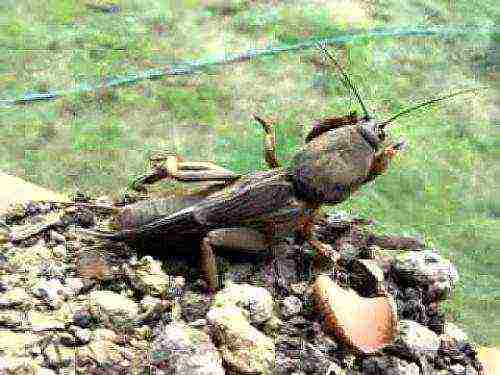
For your information: as soon as shoots appear, it is necessary to protect them from birds, as the shoots can completely destroy crows and blackbirds.
Hilling, feeding peanuts
An important component of a good harvest is hilling, which is carried out several times per season:
- Before the plants bloom, we spud the bushes to a height of 50 to 70 mm.
- 10 days after blooming.
- Regularly at intervals of 10 days, gradually reducing the distance between the roots (gynophores) formed after flowering and the soil. We carry out the last hilling in early August.
Three times per season, namely when real leaves begin to form, buds are tied, and then fruits, we apply mineral fertilizers per 1 hundredth:
- nitrogen - from 0.45 to 0.6 kg;
- phosphorus - from 0.5 to 0.6 kg;
- potassium - up to 0.45 kg, but only in sandy loam soil.
Peanuts in a warm garden
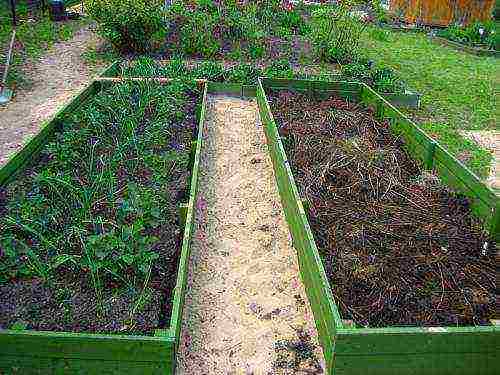
When wondering how to grow peanuts in the country, consider such an option as a warm garden bed. It is better to cook it in the fall or very early in the spring in case of emergency:
- We select a place and proceed to digging a trench to a depth of a shovel bayonet. The optimal width is 1 m, and any length.
- We store the top layer of soil on one side of the trench, and the bottom layer on the other.
- We cover the bottom with plant residues, sprinkle them with earth. Place the half-rotted compost on top.
- We cover everything with the top layer of earth.
If the soil is healthy, then after 60 days the garden bed will be filled with warm, nutritious soil suitable for growing peanuts.
Growing peanuts in a greenhouse
In a greenhouse, peanuts are comfortable, especially when grown in tandem with tomatoes, but provided that the latter are not very densely located so that light still comes to the peanuts. Legumes are shared with tomatoes with nitrogen, and often you do not need to spud the bushes - 2 times in June is enough. The harvest will ripen by September.
How to grow peanuts at home on a windowsill

After growing peanut seedlings, you can leave several plants at home, and then harvest directly on the windowsill. It is easy to do this:
- We take a wide container and fill it with soil with humus and sand added to it.
- We plant a plant in it and place it in the brightest place, making sure that there are no drafts.
- We wait until a flower appears, and a bean develops from it. It is important that the shoots do not hang outside the container, otherwise the set fruit will not develop.
- Water regularly, slightly loosen the soil.
- We collect the fruits when the bush stops growing and the leaves begin to turn yellow.
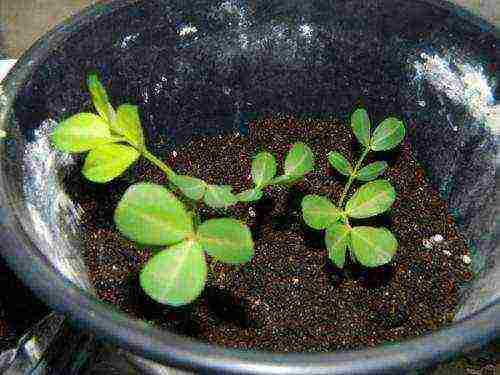
Harvest

Peanuts cannot withstand even light frosts, so harvesting should be done before they occur. Wherein:
- we sort nuts into ripe and not ripe;
- we throw away very small ones;
- we bring it into a ventilated, dry room for additional drying;
- we store in fabric bags;
- hull as needed.
If we have provided proper care, then we can count on a yield of 100 to 150 g of dry grains per 1 sq. m, or even higher.

Watch a video on how to grow peanuts:
.
A peanut (peanut) grows up to 70 cm in height, but it does not look like a fruit tree or a bush, and its fruits are not nuts, beans in a pod. Caring for it is like growing potatoes.

Growing peanuts is like growing potatoes
Areal of peanuts
The plant has been cultivated for many centuries by the local people of South America, where the largest peanut plantations can be found. For the first time, the culture was noticed by Europeans in those days when they were mastering the New World.
Peanuts were brought to our lands in 1792 from Turkey. In 1825, they first tried to acclimatize it in the Odessa Botanical Garden.
Now this culture is sown in small areas in Central Asia, Transcaucasia; in the south of Ukraine, the North Caucasus. It is more profitable to grow peanuts in Ukraine than in central Russia due to the warmer climate.
Several million hectares are used for planting peanuts worldwide, and growing areas are rapidly expanding.
Peanuts grow without problems in conditions in which other crops die from lack of moisture and nutrition. He loves the sun and dispenses with pollinators. Annual legumes, to which this crop belongs, are able not only to receive nutrients from the earth, but also saturate the earth with nitrogen.
How peanuts grow: A peanut grows well in warmth and needs long and dry summers and fall to ripen. The duration of growing a crop from planting to harvest is 120–160 days. Climatic conditions like this are rare. Suitable temperatures for plant growth range from 20 to 27 ° C.
Selection and preparation of seeds
Peanuts, like other plant species, come in many varieties. The main distinguishing feature between them is the size of the beans.
As seeds, you can use peanuts purchased from sellers in the market or in a store, only unroasted and unprocessed.
The most common varieties are:
- Virginia is a classic, common look;
- Valencia produces large beans;
- Spanish produces small beans, which are most often used to make peanut butter and other products in the confectionery industry;
- The runner has a high yield, more often it grows in the South and East of the United States.
Choose beans with undamaged or overdried hulls.
Before planting, seeds must be germinated:
- Soak in water (you can add a little potassium permanganate or epin).
- Wrap in a wet cloth, put in a warm place.
- After a few days, the seeds will swell and germinate.
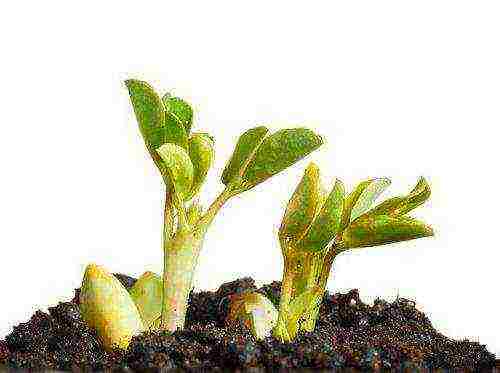
Already germinated seeds should be planted in the ground.
Soil preparation
One of the important conditions for growing peanuts is crop rotation. The culture grows well in the soil in which the peanuts were grown before planting:
- cabbage;
- cucumbers;
- tomatoes;
- potato.
It will be even more favorable if these plants are fertilized with organic matter. It is not advisable to plant a nut in an area where legumes used to grow:
- beans;
- peas;
- beans;
- lentils.
This can cause the formation of root rot.
It is best to plant seeds in wet, loose, and neutral soil. It is good if the soil contains a lot of magnesium and calcium. Cannot be planted in saline soil.
Many novice gardeners are interested in whether it is possible to plant a plant in soil with high acidity. You can, if you lime it before planting.
The landing site is prepared in advance. During autumn digging, humus is introduced into the soil to a depth of 25 to 30 cm in a ratio of 2-3 kg per 1 sq. m. In the spring, you need to dig up the soil again and add 50 g of "Nitrofoski" per 1 sq. m. m.
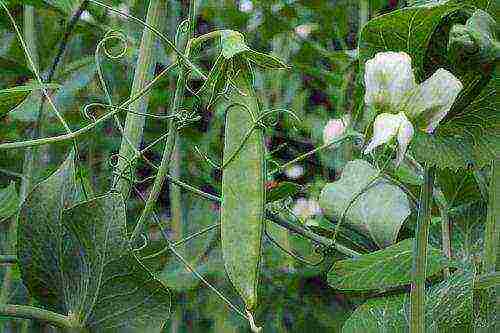
You can't plant peanuts after peas
Planting peanuts
Warm regions are most suitable for growing peanuts. It is necessary to plant seeds at a time when acacia is blooming and melons are sown (from late April to mid-May). In northern latitudes, it can be planted immediately after frosts, since they can destroy the plant. When thinking about how to grow peanuts, it is important to remember that the culture is thermophilic, does not tolerate extreme temperature changes, drafts and high levels of humidity.
The crop grows well in open, lit areas with no shade from buildings or vegetation. The favorable temperature at which growing peanuts at home will give results is more than 20 ° C. If the temperature drops by even a few degrees, the peanuts will stop growing. The film saves the plant from lowering the topics
Peanuts are planted in holes to a depth of 10 cm. There are the following ways to plant peanuts:
- staggered - the gap between the holes is 50 cm, between the rows is 25-30 cm;
- square-nested - scheme 60x60 cm or 70x70 cm;
- wide-row - width between rows 60-70 cm, between plants 15-20 cm.
After planting, the soil should be moist, but it should not be overflowed.
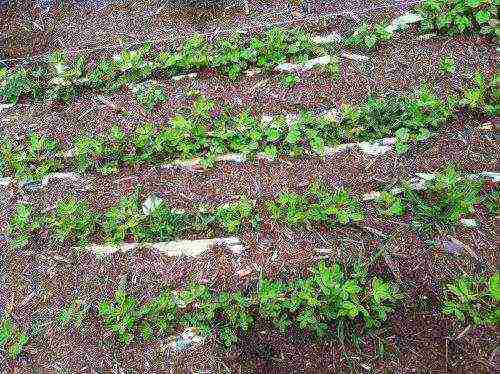
Peanuts grow well in open areas
Growing in the country
To grow peanuts in the country, varieties were specially bred:
- Valencia Ukrainian;
- Stepnyak;
- Krasnodar.
For sowing, choose a bright, sunny area with suitable soil.
Planting of peanuts is carried out in the spring in open ground. It is desirable that the weather has already stabilized, the earth has been warmed up, the most favorable temperature is about 15 ° C.
How to plant peanuts in the garden correctly:
- Make holes in a checkerboard pattern to a depth of 10 cm at a distance of 50 cm from each other.
- You need to put 3-4 seeds in one hole.
- Excessive watering causes seed rot.
The main care of a young plant is watering, weeding, loosening the soil and fertilizing. It is convenient to remove weeds along with loosening the soil.
The seeds should germinate in a month if planting and maintenance has been done correctly. The plant grows to a height of 25 to 75 cm.By the end of flowering, 1.5–2 months after planting, the ovary will begin to grow into the soil, gradually dropping.
Fruits will ripen underground. The soil needs to be hilled or mulched using humus, sand, sawdust or peat. The layer of mulch should be up to 5 cm thick. Peanuts should be spud 4-5 times. At the site of the growth of the bush, about 30-50 beans can ripen, each of them ripens from 1 to 7 seeds.
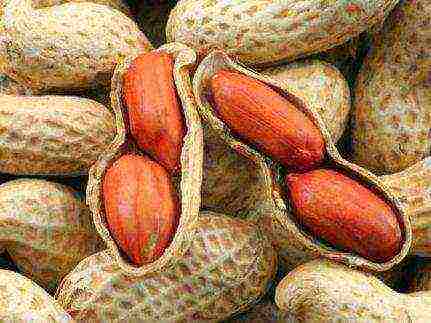
Peanuts Valencia Ukrainian suitable for growing in the country
Growing in a greenhouse and at home
How to grow peanuts in the country if you use a greenhouse:
- Select a planting area for seeds close to the glass.
- Plant them between the tomatoes, removing the bottom leaves of the last one to make room for the peanuts. Tomatoes will also benefit from such a neighborhood: peanuts release the nitrogen they need.
If the climate in your area does not allow planting peanuts in the garden, do not be upset. There is another way how to grow peanuts at home. The original walnut bushes grow well in a pot on the windowsill in the house.
For planting, take peeled unroasted nuts or a whole fruit, squeezing the shutters so that they burst. Seeds can be germinated before planting.
How to grow peanuts at home:
- Place the seeds 2 cm deep in the center of the pot, which is filled with equal parts of earth with sand and humus.
- Pour over and cover with cut foil for ventilation.
- Place in a warm, bright place (at least 20 ° C). Do not allow the soil to dry out and moisture stagnation. With regular spraying, you can water it every 10-14 days.
- After 2–3 weeks, clover-like sprouts will appear. Thin them and leave the strongest shoots. The plant begins to bloom soon.
The branch on which the fruits appeared begins to descend, since the fruits ripen in the ground.
Peanuts are an annual plant, therefore, after flowering, its development slows down: all forces are spent on ripening the fruits.
If the lighting is insufficient, then the growth and formation of shoots slows down, there are few flowers, the fruits do not ripen. The best place for a pot of peanuts is south or east, but at noon it should be hidden from direct sunlight. The lack of light is compensated by special lamps. The plant must be protected from drafts, otherwise it may die.
In 2.5–3 months after the formation of young shoots, reddening of the leaves of the plant begins, this indicates that the fruits are ripe.
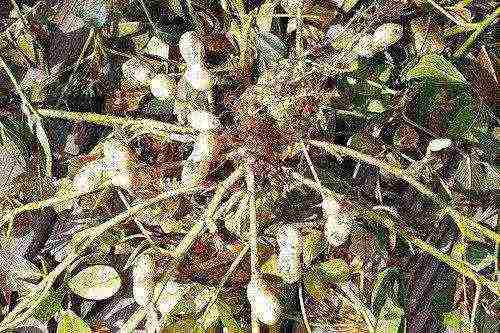
Peanut fruits ripen in the ground
Harvesting
When the bush stops growing, the crop can be harvested. The peanuts must be removed from the ground and the fruits will be visible on the roots. They are usually harvested in the second half of September. If the leaves began to turn yellow, then the culture is ripe. You can remove a couple of beans from the soil and see if the seeds are easily husked from them, if so, then the fruit is ripe. There is no need to hesitate with harvesting, collecting the fruits before the cold weather, because after the freezing of the earth, the seeds can accumulate bitterness. A pitchfork is used to dig out bushes. The beans are separated from the stems and laid out in the fresh air, but in the shade, to dry. When the shell is dry, the beans are removed and poured into cloth bags. Peanuts are stored in a dry room with good ventilation at a temperature not exceeding 10 ° C.
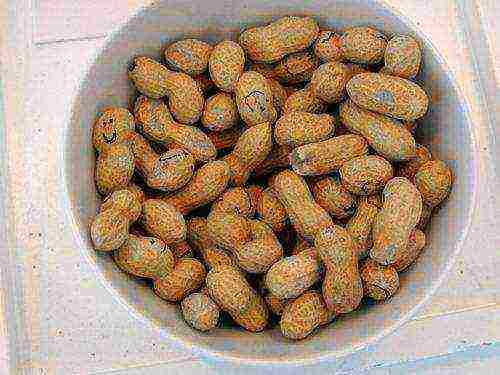
After harvesting, the peanuts should be well dried.
Peanut diseases
It is necessary to protect the cultivated nut from the influence of harmful external factors.
The most common peanut diseases are:
- Phylostictosis (leaf spot): small brownish-brown spots gradually grow to a diameter of 6 mm. Then the middle of the spot fades, the fabric dies, the edge of the spot turns purple. The disease progresses during a period of high humidity. Treatment: spraying with broad-spectrum fungicides.
- Powdery mildew, the first sign of which are single specks of powdery coating on the outer and inner sides of the leaf, over time they fill the entire leaf, which turns yellow and dries up.The disease spreads to the stem and embryos. Treatment: treatment of the plant with drugs: "Bravo", "Quadris", "Ridomil", "Switch", "Horus", "Skor", "Topaz".
- Alternaria (black spot) occurs if damp and warm weather is observed at the end of the growing season. Black spots with a diameter of 15 cm appear along the edges of the leaves, their growth leads to the death of the edges of the leaf. On the spots, a black coating of the fungus is clearly visible. To prevent the disease, you must follow the rules of specific agricultural technology.
- Fusarium wilting. The main symptom is rot in the root area, which slows down the growth and development of the plant, leads to the yellowness of its stem and leaves, it dies. The disease is dangerous in that it is characterized by a temporary attenuation, and during flowering and fruit formation it appears again. Peanuts die before they are harvested.
- Gray rot appears at the end of the flowering culture, the manifestation is brown spots on the leaves, which can go to the stem. The disease causes the absence of fruits or deformation of the already formed ones. If the plants grew in late summer in humid and warm weather, then it progresses. Growing peanuts in an area with a high agricultural background will prevent disease.
Also, pests can attack the culture:
- thrips (treatment with insectoacaricide helps);
- aphids and caterpillars (removed by wood ash with tobacco dust);
- clicker larvae (wireworm). The method of struggle is pit-traps with pieces of carrots, potatoes and beets. The pits are covered with boards, slate or a sheet of metal, eliminating after a certain period of time the larvae that have crawled to feed.
Subscribe Be aware of new products on our site
Many gardeners are wondering how to grow peanuts on their own plot. The plant is native to South America, but the climate of the middle European zone is quite suitable for the cultivation of exotic peanuts. To obtain a harvest, you need to purchase seed material and study agricultural technology.
Peanuts - planting and growing at home
Ground peanuts are an annual plant, sown annually. It belongs to the legume family and tastes like a real nut. Its fruits are formed in a peel in several pieces, grow underground. The lower pollinated flowers of the plant stretch towards the soil and gradually sink completely into it, after which the emergence of the crop begins. For peanuts, the simple method of growing in ordinary pots located at home on the windowsill is also fine. You just need to plant it in light soil, provide a sufficient amount of light, and protect it from drafts.
How to plant peanuts at home?
Before planting peanuts at home, you need to prepare a wide container (30-40 cm in diameter) so that later its shoots do not hang around the edges of the pot. The optimum seeding time is mid-April. Landing rules:
- seeds are best purchased in specialized stores, they are soaked in water overnight, adding a drop of Epin there. By morning, the nuts open slightly and the spine is shown;
- the substrate is prepared from humus and sand, taken in equal parts;
- it is convenient to plant seeds in peat tablets (this method will require further transplantation) or immediately to a permanent place;
- the container is filled with a moist substrate;
- the germinated seed is planted in the middle to a depth of 2-2.5 cm;
- to create a warm microclimate, the pot is covered with cellophane and placed in a warm place;
- for germination, the greenhouse is regularly ventilated.
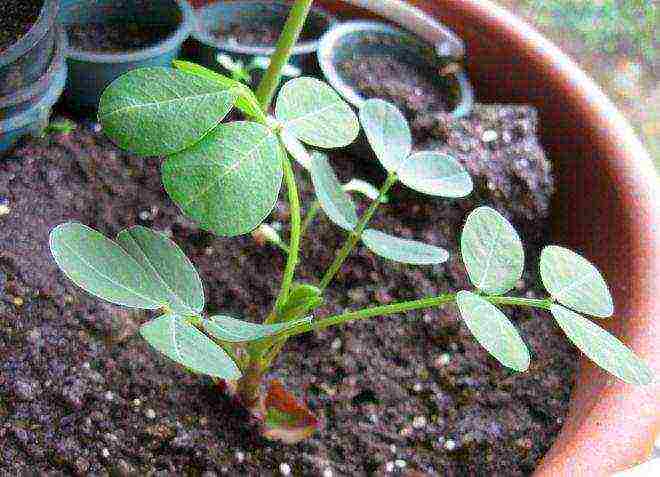
Home care for peanuts
For the successful development of the plant, it is required to observe agricultural techniques for the cultivation of peanuts. How to grow peanuts at home in a pot:
- Watering. It is necessary to moisten the seedlings regularly, avoiding coma sputum.
- Spraying. On hot days, the sprout is irrigated with water at room temperature in the morning and evening.
- Temperature conditions. Optimal - + 20-27 ° С, conditions below + 15 ° С and above + 30 ° С destroy the fetus.
- Hilling. It is carried out at the end of July to a height of 3 cm, then twice more in August by 1.5-2 cm.
Upon reaching a height of 20 cm, the plant blooms (40-45 days). In place of the orange petals, ovaries appear, which burrow into the ground. Fruits are formed at a depth of 8-10 cm. Yellowed leaves will be a signal for harvesting. The plant is pulled out of the ground, laid out in the sun to dry. After 10-12 days, the nuts will begin to separate well from the shell. Each bush produces about fifty beans with 1-7 nuts inside the shell.
How to grow peanuts in the garden?
Before growing peanuts in the open field, it is important to familiarize yourself with some of the features of its cultivation. For planting a nut, choose open areas with good ventilation and bright lighting. The best predecessors are potatoes, cucumbers, cabbage. After legumes, growing a good harvest is difficult. The soil is needed loose, permeable, neutral. Peanuts grow when planted and nursed in the open field at a temperature of + 20 ° C. When it decreases, the development of the plant stops, in this case it is advisable to cover the culture with a film.
How to plant peanut seedlings in the country?
The seeds are pre-soaked at the end of April (you can still place them in a potassium permanganate solution for 30 minutes), after 10 days sprouts appear on them. The beans are then placed in open ground. After germination, the peanut will develop faster. This method will protect the bean from the bear, which often eats seeds in the ground. It is better to choose large specimens for sowing, small fruits may not sprout at all. How to plant peanuts in the garden:
- landing is carried out in holes 10 cm deep with a distance of 50 cm between specimens. You can plant in rows with a distance of 30 cm or a checkerboard method;
- you can grow peanuts in squares 60x60 or 70x70 cm;
- the soil should be loose and fluffy, since the culture prefers soft soil;
- sprouted beans are used for planting, the remains from the valves can also be thrown into the hole - they will play the role of fertilizer for the roots;
- 3 seeds are placed in each hole, because the weak may not ascend;
- after planting, the bed is irrigated with a weak pressure so as not to wash off the upper layer of the soil;
- seedlings grow within a month to a height of 25-75 cm.

Planting time for peanuts
Since peanuts can only be grown in a warm environment, sowing is done after the soil temperature warms up to + 15 ° C. This occurs in mid-May after the incorporation of melons and gourds. Frosts are detrimental to the peanuts, therefore, before planting peanuts in the country in the open ground, you must wait for the settled warm weather. You can put the beans in glasses 3-4 cm in diameter in April, put them on a sunny windowsill. Then the seedlings are transferred to the open ground at the beginning of June.
Outdoor peanut care
Groundnuts, peanuts, when grown in the open field, need regular care - they need watering, feeding, and pest control. Young low seedlings must be protected from weeds. Weeding the rows is combined with loosening the soil after it has been moistened. After the leaves of the plant turn yellow and the seeds begin to peel off easily from the beans, it is time for harvest (the second half of September). First, the bushes are dug up, the fruits are allowed to dry out. Store the crop at the stage of unhulled beans in fabric bags in a dry room at + 8-10 ° C. Up to 0.5 kg of nuts are harvested from one bush.

Features of growing peanuts in the open field
The peanut has an interesting feature - it blooms for one day. Sometimes this process takes place almost imperceptibly for gardeners. Early in the morning in June, the buds bloom, and in the evening they already wither - during this time they have time to pollinate. After 1.5-2 months after flowering, the ovaries descend into the ground, germinate deeper, where the formation of the fruits of the culture will take place.
Growing peanuts in the garden is accompanied by the obligatory hilling.10 days after flowering, the ovaries are sprinkled with moist, loose soil 5-7 cm (like potatoes) so that the nutrient medium reaches the receptacle. As a rule, two more hillocks with a break of 10 days will help to grow peanuts, during which the stem of the plant is gradually covered. The procedure is recommended after watering or rain.
Conditions for growing peanuts - soil
It is important for gardeners to know where peanuts are grown. The site should be open without a hint of shadow from fences, buildings, trees. Soil for peanuts needs moist, light, with a high percentage of humus, calcium and magnesium - black soil or sandy loam. The culture does not tolerate saline soils, and acidic soils must be limed before planting. Before growing peanuts, the site is prepared: during autumn digging to a depth of 30 cm, 1-3 kg of humus are added to the ground per 1 m2 of the site. In the spring, the planting site is shallowly loosened again with the addition of 50 grams of nitrophosphate for each m2.
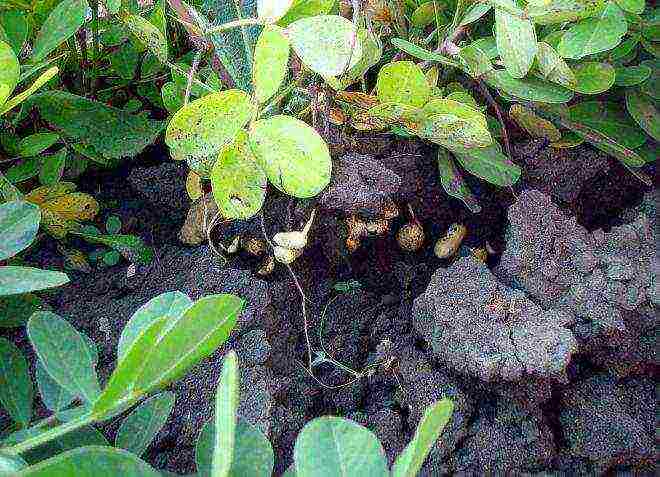
How to plant peanuts correctly - features of watering
The groundnut prefers moist rather than wet soil. Excessive watering can lead to fruit rot. How to grow groundnuts in the country - irrigation:
- moisten the culture if the upper layer of the soil dries out - approximately once a day of the week;
- at the flowering stage, the sprouts are watered abundantly - in the morning, once or twice a week;
- the water for the procedure should not be cold - it must be slightly warmed up in the sun;
- after the formation of the ovary, instead of watering, it is recommended to spray every other day in the evening;
- after each moistening, the soil is loosened so that it is enriched with oxygen;
- if there are regular rains in the area, watering can be skipped;
- moistening is stopped a month before harvesting. If the plant is watered heavily in September, the fruits will ripen longer.
Growing peanuts - feeding
The peanuts are fed twice a season. Fertilizers are good for growth and yield. The plant reacts favorably to potassium and phosphorus. How to grow peanuts in the country - fertilizers:
- the initial recharge is made after the foliage reaches 10 cm in height - the bush is fed with 20 g of ammonium nitrate, 45 g of potassium salt, 70 g of superphosphate per 10 liters of water;
- the second time feeding is repeated at the fruiting stage.
How to grow peanuts - diseases and pests?
Like all legumes, the nut is attacked by diseases and pests. How to grow peanuts in the country - the fight against parasites:
- Peanuts are annoyed by aphids, caterpillars. They harm foliage, spoil the flowering process. You can get rid of parasites by sprinkling the ridge with wood ash or tobacco dust.
- From thrips, the plant is sprayed with insecticides.
- It is dangerous if wireworms begin to eat the nut - they live in the ground and gnaw the fruit even in the peel. To destroy them, trap pits are made, in which particles of potatoes, beets or carrots are placed. The holes are covered with boards, metal, and after a while the larvae that have crawled to feed are removed.
- It is also recommended to install a scarecrow on the bed with peanuts to scare away birds that can damage all the fruits.
How to grow quality peanuts - diseases:
- Powdery mildew. The disease appears as blotches of plaque on both sides of the leaves. In case of defeat, fungicides will help - Topaz, Bravo, Quadris.
- Phylostictosis or leaf spot. It is recognized by brown glades up to 6 mm in diameter, which progress at high humidity. Broad-spectrum fungicides are effective in combating the disease.
- Gray rot. Appears after flowering in the form of rusty spots passing from leaves to stems. Fruits do not ripen on the affected bushes. Adherence to agricultural techniques for the development of culture, maintaining crop rotation, and timely feeding will help to grow a healthy bush.
